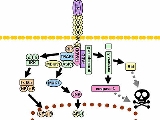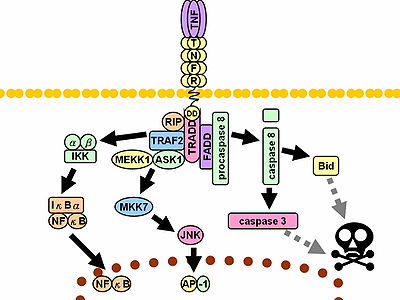
TRADD
Encyclopedia
Tumor necrosis factor receptor type 1-associated DEATH domain protein is a protein
that in humans is encoded by the TRADD gene
.
TRADD is an adaptor protein
.
/TNFR1 and mediates programmed cell death
signaling and NF-kappaB activation. This protein binds adaptor protein TRAF2
, reduces the recruitment of inhibitor-of-apoptosis proteins (IAPs) by TRAF2, and thus suppresses TRAF2 mediated apoptosis. This protein can also interact with receptor TNFRSF6/FAS
and adaptor protein FADD
/MORT1, and is involved in the Fas-induced cell death pathway.

with STAT1
, TNFRSF1A
, FADD
, TNFRSF25
, TRAF2
, Keratin 18
and RIPK1
.
Protein
Proteins are biochemical compounds consisting of one or more polypeptides typically folded into a globular or fibrous form, facilitating a biological function. A polypeptide is a single linear polymer chain of amino acids bonded together by peptide bonds between the carboxyl and amino groups of...
that in humans is encoded by the TRADD gene
Gene
A gene is a molecular unit of heredity of a living organism. It is a name given to some stretches of DNA and RNA that code for a type of protein or for an RNA chain that has a function in the organism. Living beings depend on genes, as they specify all proteins and functional RNA chains...
.
TRADD is an adaptor protein
Adaptor protein
Signal transducing adaptor proteins are proteins which are accessory to main proteins in a signal transduction pathway. These proteins tend to lack any intrinsic enzymatic activity themselves but instead mediate specific protein–protein interactions that drive the formation of protein complexes...
.
Function
The protein encoded by this gene is a death domain containing adaptor molecule that interacts with TNFRSF1ATNFRSF1A
Tumor necrosis factor receptor superfamily member 1A is a protein that in humans is encoded by the TNFRSF1A gene. The protein encoded by this gene is a member of the Tumor necrosis factor receptor superfamily, which also contains TNFRSF1B. This protein is one of the major receptors for the tumor...
/TNFR1 and mediates programmed cell death
Programmed cell death
Programmed cell-death is death of a cell in any form, mediated by an intracellular program. PCD is carried out in a regulated process which generally confers advantage during an organism's life-cycle...
signaling and NF-kappaB activation. This protein binds adaptor protein TRAF2
TRAF2
TNF receptor-associated factor 2 is a protein that in humans is encoded by the TRAF2 gene.-Interactions:TRAF2 has been shown to interact with BCL10, CD30, CFLAR, IKK2, MAP3K7IP2, CD137, Caveolin 1, CD27, TNFRSF13B, TANK-binding kinase 1, TRAF1, CD40, UBE2N, MAP3K14, MAP4K2, CASP8AP2, HIVEP3,...
, reduces the recruitment of inhibitor-of-apoptosis proteins (IAPs) by TRAF2, and thus suppresses TRAF2 mediated apoptosis. This protein can also interact with receptor TNFRSF6/FAS
Fas receptor
The FAS receptor also known as apoptosis antigen 1 , cluster of differentiation 95 or tumor necrosis factor receptor superfamily member 6 is a protein that in humans is encoded by the TNFRSF6 gene....
and adaptor protein FADD
FADD
Fas-Associated protein with Death Domain is an adaptor molecule that bridges the Fas-receptor, and other death receptors, to caspase-8 through its death domain to form the death-inducing signaling complex during apoptosis. -Signalling:...
/MORT1, and is involved in the Fas-induced cell death pathway.

Interactions
TRADD has been shown to interactProtein-protein interaction
Protein–protein interactions occur when two or more proteins bind together, often to carry out their biological function. Many of the most important molecular processes in the cell such as DNA replication are carried out by large molecular machines that are built from a large number of protein...
with STAT1
STAT1
STAT1 is a member of the Signal Transducers and Activators of Transcription family of transcription factors. STAT1 is involved in upregulating genes due to a signal by either type I, type II or type III interferons...
, TNFRSF1A
TNFRSF1A
Tumor necrosis factor receptor superfamily member 1A is a protein that in humans is encoded by the TNFRSF1A gene. The protein encoded by this gene is a member of the Tumor necrosis factor receptor superfamily, which also contains TNFRSF1B. This protein is one of the major receptors for the tumor...
, FADD
FADD
Fas-Associated protein with Death Domain is an adaptor molecule that bridges the Fas-receptor, and other death receptors, to caspase-8 through its death domain to form the death-inducing signaling complex during apoptosis. -Signalling:...
, TNFRSF25
TNFRSF25
Tumor necrosis factor receptor superfamily member 25 is a protein that in humans is encoded by the TNFRSF25 gene.-Further reading:...
, TRAF2
TRAF2
TNF receptor-associated factor 2 is a protein that in humans is encoded by the TRAF2 gene.-Interactions:TRAF2 has been shown to interact with BCL10, CD30, CFLAR, IKK2, MAP3K7IP2, CD137, Caveolin 1, CD27, TNFRSF13B, TANK-binding kinase 1, TRAF1, CD40, UBE2N, MAP3K14, MAP4K2, CASP8AP2, HIVEP3,...
, Keratin 18
Keratin 18
Keratin 18 is a type I cytokeratin. It is, together with its filament partner keratin 8, perhaps the most commonly found products of the intermediate filament gene family. They are expressed in single layer epithelial tissues of the body. Mutations in this gene have been linked to cryptogenic...
and RIPK1
RIPK1
Receptor-interacting serine/threonine-protein kinase 1 is an enzyme that in humans is encoded by the RIPK1 gene.-Interactions:RIPK1 has been shown to interact with CA11, RIPK3, RNF11, Baculoviral IAP repeat-containing protein 3, CFLAR, BIRC2, Caspase 8, RNF216, TNFRSF1A, Sequestosome 1, TRAF2,...
.

